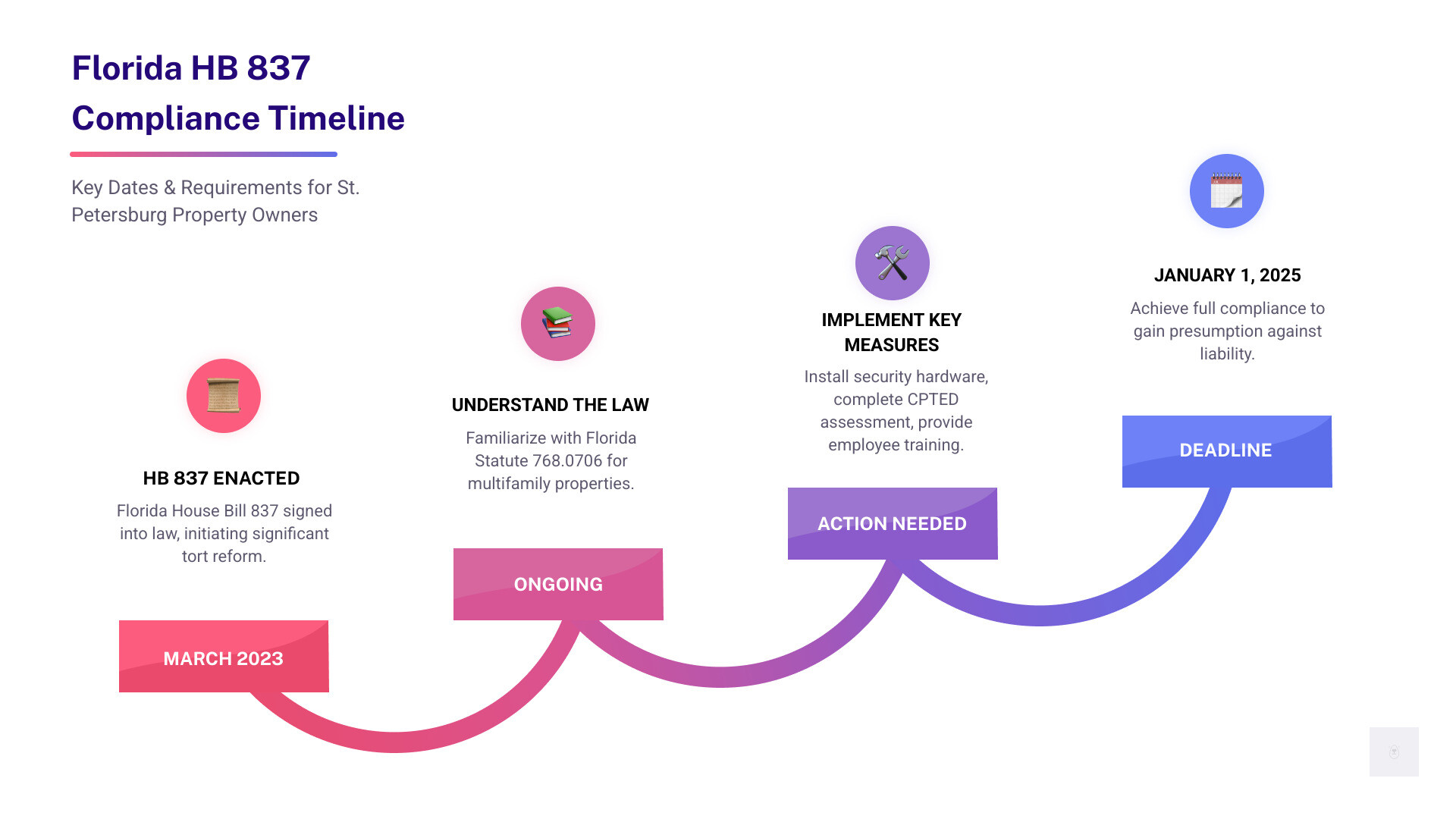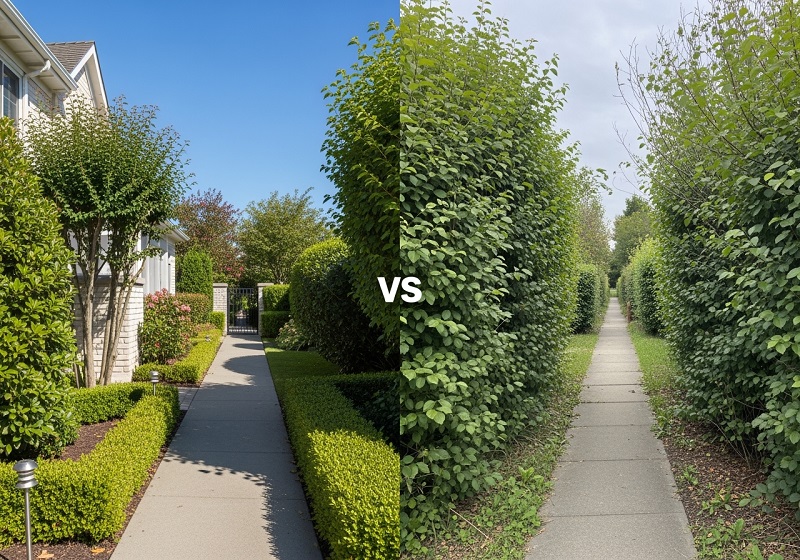Navigating Florida HB 837 Compliance: A Guide for Property Owners
 A significant deadline is rapidly approaching for multifamily property owners in St. Petersburg. By January 1, 2025, new legal requirements will be in full effect. Florida Statute 768.0706, driven by Florida HB 837, introduces important safety standards.
A significant deadline is rapidly approaching for multifamily property owners in St. Petersburg. By January 1, 2025, new legal requirements will be in full effect. Florida Statute 768.0706, driven by Florida HB 837, introduces important safety standards.
These new rules aim to improve security within multifamily residential properties. They also offer a crucial presumption against liability for properties that meet specific criteria. This means understanding and acting on these regulations is not just about compliance; it’s about protecting your assets and residents.
In this comprehensive guide, we will explore what these laws mean for you. We will cover the specific requirements, the vital role of CPTED assessments, and the many benefits of achieving compliance. Our goal is to help you steer these changes effectively.

Florida House Bill 837 (HB 837), enacted in March 2023, represents a significant tort reform that profoundly impacts multifamily property owners across the state, including those in St. Petersburg. Its primary aim is to reduce frivolous lawsuits and provide a liability shield for property owners who proactively implement specific crime prevention measures. This legislation specifically targets multifamily housing, encompassing condominiums, townhome communities, and apartment complexes with five or more units.
The implications are clear: compliance is no longer merely a best practice; it’s a legal imperative that can safeguard your property from costly litigation and improve resident safety.
The Three Pillars of Florida HB 837 Compliance
To benefit from the presumption against liability offered by Florida Statute 768.0706, multifamily property owners must satisfy three core requirements. These pillars form the foundation of a robust security strategy and demonstrate a commitment to resident safety.
- Implementing Specific Security Measures: This involves the installation and maintenance of foundational security hardware across the property.
- Completing a CPTED Assessment: A professional Crime Prevention Through Environmental Design (CPTED) assessment is mandatory to identify vulnerabilities and recommend improvements based on environmental design principles.
- Providing Employee Safety Training: All staff must receive proper training in crime deterrence and safety protocols to ensure a consistent and informed approach to security.
Let’s dig into each of these pillars in more detail.
1. Implementing Specific Security Measures
Florida Statute 768.0706(2)(a) outlines several mandatory physical security improvements that multifamily properties must install and maintain. These measures are designed to deter criminal activity and improve the overall safety of residents and visitors.
- 1-inch Deadbolts: All dwelling unit entry doors must be equipped with a 1-inch deadbolt lock. This provides a significant barrier against forced entry compared to standard spring-latch locks.
- Locking Windows and Sliding Doors: All windows and exterior sliding doors of dwelling units must be fitted with locking devices. This includes ensuring that any glass elements within or adjacent to doors are secured against easy breakage and access.
- Door Peepholes or Viewers: Each dwelling unit entry door must have a peephole or other door viewer that allows residents to identify visitors before opening their doors, enhancing personal safety.
- Lighting in Common Areas: Adequate lighting is crucial for deterring crime. Common areas, such as walkways, stairwells, laundry rooms, and parking lots, must have proper lighting that is functional from dusk till dawn. This includes ensuring a minimum of 1.8 foot-candles of illumination in parking lots to eliminate dark spots and improve visibility.
- Pool Gate Security: If the property features a swimming pool, its access gates must be securely locked and controlled, ideally with key or fob access, to prevent unauthorized entry and improve safety.
These physical measures are the first line of defense and a tangible demonstration of a property owner’s commitment to security.
2. Completing a CPTED Assessment
Beyond basic hardware, the law mandates a comprehensive CPTED assessment. CPTED, or Crime Prevention Through Environmental Design, is a multidisciplinary approach to deterring criminal behavior through thoughtful design and management of the built environment.
The assessment must be conducted by a qualified professional. This means either a certified Florida Crime Prevention Through Environmental Design Practitioner (FCP) or a designated employee of a law enforcement agency who has received CPTED training. The assessment involves a thorough review of the property’s design, layout, landscaping, lighting, and other environmental factors to identify potential vulnerabilities that could be exploited by criminals.
Crucially, this certification is not a one-time event. The CPTED assessment must be renewed every 3 years to ensure ongoing compliance and to adapt to any changes in the property or local crime patterns. Proper documentation of the inspection and any recommended remediation is essential for maintaining the liability shield.
3. Providing Employee Safety Training
The human element is just as vital as physical security. Florida HB 837 requires multifamily property owners to provide documented crime deterrence and safety training to all staff. This training equips employees with the knowledge and skills to identify and report suspicious activities, respond appropriately to security incidents, and understand their role in maintaining a safe environment.
- Deadline for Current Employees: All current employees must complete this training by January 1, 2025.
- 60-Day Requirement for New Hires: Any new employees hired after the initial deadline must receive the training within 60 days of their employment start date.
This training typically covers various topics, including emergency procedures, recognizing potential threats, proper reporting protocols, and the importance of maintaining security measures. It applies to a wide range of staff, including maintenance personnel, administrative staff, security guards, and property managers. Some providers offer convenient virtual training options, with costs as low as $20 per person, making it accessible for properties of all sizes.
The Core of Compliance: What is a CPTED Assessment?

At its heart, compliance with Florida Statute 768.0706 revolves around the CPTED assessment. CPTED, or Crime Prevention Through Environmental Design, is a proactive approach to enhancing safety by strategically modifying the physical environment. It’s about designing out crime, rather than just reacting to it. This involves understanding how people interact with their surroundings and how environmental factors can either encourage or discourage criminal activity.
CPTED moves beyond traditional security measures like alarms and guards, focusing on the underlying environmental conditions that contribute to crime. By applying these principles, properties can become inherently safer, reducing opportunities for crime and fostering a greater sense of security among residents.
CPTED Principles Explained
The CPTED methodology is built upon several core principles:
- Natural Surveillance: This principle emphasizes designing spaces that maximize visibility. Good sightlines, appropriate landscaping, and effective lighting allow residents and visitors to see and be seen, creating a sense of constant observation that deters potential criminals. For example, avoiding tall shrubs near pathways or ensuring clear views into common areas.
- Natural Access Control: This involves guiding people and vehicles through a property in a way that limits access to legitimate users and discourages unauthorized entry. This can be achieved through strategic placement of entrances, fencing, landscaping, and clear signage, making it evident who belongs and where they should go.
- Territorial Reinforcement: This principle promotes a sense of ownership and responsibility over a space. Clearly defined boundaries, well-maintained landscaping, and personalized elements can signal that a space is cared for and monitored, making it less attractive to criminals. Examples include decorative fencing, consistent signage, and community gardens.
- Maintenance and Management: A well-maintained property sends a message that the area is supervised and cared for. Neglected or dilapidated environments can signal a lack of oversight, inviting criminal activity. Regular upkeep, prompt repairs, and swift removal of graffiti or litter are crucial for maintaining a strong security posture.
Key Components of a Professional CPTED Inspection
A professional CPTED assessment is a comprehensive evaluation that goes beyond a simple checklist. It typically involves multiple stages and detailed analysis:
- Daytime Inspection: During the day, the assessor evaluates the property’s overall layout, landscaping, building design, and pedestrian flow. This includes assessing entry and exit points, visibility into common areas, and the presence of natural barriers or hiding spots.
- Nighttime Inspection: A crucial component, the nighttime inspection focuses specifically on lighting conditions. The assessor will evaluate the adequacy and effectiveness of lighting in all common areas, pathways, and parking lots. This is where specialized tools come into play.
- Parking Lot Illumination Check: Using professional light meters, the assessor measures the foot-candle levels in parking areas, ensuring they meet the minimum requirement of 1.8 foot-candles. This is critical for both safety and compliance.

- Landscaping Review: Overgrown bushes or trees can provide cover for criminals. The assessment includes recommendations for trimming or removing vegetation that obstructs sightlines or creates secluded areas.
- Signage and Wayfinding: Clear and unambiguous signage helps legitimate users steer the property while also deterring unauthorized individuals. The assessment examines the clarity and placement of directional signs, warning signs, and property rules.
- Security Camera Placement: While not a CPTED principle itself, the assessment will often include recommendations for optimal placement of security cameras to maximize coverage and effectiveness, especially at all community entrances and exits, with recordings saved for at least 30 days.
- Access Control Points: Evaluation of gates, doors, and other entry points to ensure they are properly secured and function effectively to control who enters and exits the property.
The findings from these inspections are compiled into a detailed report, often including visual documentation and specific recommendations for improvement. This report serves as critical documentation for compliance and a roadmap for enhancing property security.
The Stakes: Benefits of Compliance vs. Consequences of Neglect
Understanding the requirements of Florida Statute 768.0706 and HB 837 is one thing; appreciating the profound impact of compliance—or non-compliance—is another. For multifamily property owners in St. Petersburg, the choice to accept these new standards carries significant financial, legal, and operational weight.
The Financial Impact of Florida HB 837 Compliance
Achieving and maintaining compliance with HB 837 and Florida Statute 768.0706 offers a multitude of financial advantages:
- Liability Insurance Discounts: One of the most immediate and tangible benefits is the potential for reduced insurance premiums. Certified associations are already seeing liability insurance discounts of up to 15%. These savings can significantly offset the cost of assessments and security upgrades.
- Reduced Legal Risk: The primary incentive of HB 837 is the “presumption against liability” in security negligence cases. This legal shield can drastically reduce a property owner’s exposure to costly and time-consuming lawsuits stemming from criminal acts on their property. By demonstrating due diligence and adherence to statutory requirements, the burden of proof shifts, making it far more challenging for plaintiffs to successfully sue for security negligence.
- Increased Property Value: A safer, more secure property is inherently more attractive to prospective residents and investors. Compliance can improve property value by reducing perceived risks and improving the overall living environment.
- Tenant Satisfaction and Retention: Residents prioritize safety. A property that visibly invests in security measures, undergoes regular assessments, and trains its staff fosters a stronger sense of community and well-being. This leads to higher tenant satisfaction, reduced turnover, and a more stable rental income stream.
The Risks of Non-Compliance
Conversely, neglecting the requirements of HB 837 can lead to severe consequences:
- Loss of Liability Protection: Without compliance, property owners remain fully exposed to security negligence lawsuits. In such cases, they would lack the legal presumption against liability, making them more vulnerable to adverse judgments and substantial financial penalties.
- Higher Insurance Premiums and Policy Non-Renewal: Non-compliant properties are viewed as higher risk by insurance providers. This can result in significantly increased liability insurance premiums, or even the outright non-renewal of policies, leaving properties uninsured or underinsured against critical risks.
- Increased Vulnerability to Crime: Without a professional CPTED assessment and the implementation of recommended security measures, properties may remain susceptible to criminal activity. This not only endangers residents but can also lead to property damage and a decline in reputation.
- Legal Exposure: Beyond direct lawsuits, non-compliance can lead to regulatory fines and other legal challenges. The costs associated with defending against legal action, even if successful, can be substantial, including attorney fees, court costs, and management time.
Here’s a comparison of the benefits of compliance versus the risks of non-compliance:
Finding a Qualified CPTED Assessor in St. Petersburg
The success of your HB 837 compliance journey hinges significantly on selecting the right CPTED assessment service. Given the technical nature of CPTED principles and the legal implications of the statute, it’s paramount to engage a qualified and experienced provider, especially one with local expertise in St. Petersburg.
The law specifies that a CPTED assessment must be conducted by a certified Florida Crime Prevention Through Environmental Design Practitioner (FCP) or a designated employee of a law enforcement agency with CPTED training. When evaluating potential service providers, verifying their FCP certification is a non-negotiable first step. This ensures they possess the specialized knowledge required to interpret and apply CPTED principles effectively within the context of Florida law.
Local expertise is also invaluable. A St. Petersburg-based assessor will have a nuanced understanding of local crime trends, community dynamics, and specific environmental factors unique to the area. This local insight can lead to more accurate assessments and more effective, custom recommendations. Working with a local expert on Tricorn Florida HB 837 compliance is a critical step towards ensuring properties meet the necessary safety standards and secure the liability protections offered by the new legislation.
When interviewing potential CPTED assessment service providers, consider asking the following questions:
- “Are you an FCP-designated practitioner, or is your team comprised of law enforcement personnel with CPTED training?” (Essential for statutory compliance.)
- “What is your experience specifically with multifamily properties in St. Petersburg or similar Florida communities?” (To gauge local expertise.)
- “What does your CPTED assessment process involve, including daytime and nighttime inspections?” (To ensure a comprehensive evaluation.)
- “What is included in your final report, and how detailed are your recommendations?” (Look for clear, actionable steps with visual support.)
- “Do you provide assistance with remediation planning or follow-up consultations?” (Some companies offer additional support beyond the initial assessment.)
- “Can you provide references from other multifamily property owners you’ve assisted with HB 837 compliance?” (To verify their track record.)
- “How do you handle the required documentation for compliance, and is it suitable for legal purposes?” (Crucial for the liability shield.)
- “Do you offer employee training, or can you recommend a compliant training provider?” (To address the third pillar of compliance.)
Choosing the right partner for your CPTED assessment is an investment in your property’s safety, compliance, and long-term financial health.
Frequently Asked Questions about 768.0706 Compliance
As the January 1, 2025 deadline approaches, many multifamily property owners in St. Petersburg have similar questions regarding Florida Statute 768.0706 and HB 837 compliance. Here, we address some of the most common inquiries.
How much does a CPTED assessment typically cost?
The cost of a CPTED assessment can vary depending on several factors, primarily the size and complexity of your property. Generally, these studies typically range from $2,000 to $8,000. Factors influencing the price include:
- Number of Units: Larger properties with more dwelling units and common areas will naturally require more extensive assessment time.
- Property Layout: Complex layouts, multiple buildings, varied terrain, or extensive amenities can increase the assessment’s scope.
- Specific Challenges: Properties with existing high crime rates or unique security concerns might necessitate a more in-depth analysis.
It’s important to view this cost as an investment that can lead to significant savings in insurance premiums and protection against potential liability.
What specific properties are affected by this law?
Florida Statute 768.0706, as a result of HB 837, applies to multifamily residential properties that consist of five or more units. This broad definition includes:
- Condominium associations
- Apartment complexes
- Townhome communities
- Other similar residential properties meeting the unit threshold.
If your property falls into any of these categories, compliance is mandatory to secure the benefits of the liability shield.
How often do I need to get a CPTED assessment?
The CPTED certification is not a one-time requirement. To maintain ongoing compliance and the presumption against liability, the assessment must be renewed every 3 years. This ensures that your property’s security measures remain current and effective, adapting to any physical changes to the property or shifts in local crime patterns.
Maintaining proper documentation of each assessment, including the date of completion and any remediation efforts, is crucial for demonstrating continuous adherence to the statute. This regular review reinforces the proactive safety approach that CPTED advocates.
Conclusion: Proactive Safety is Smart Business
The landscape of property liability and security for multifamily owners in St. Petersburg has been fundamentally reshaped by Florida HB 837 and Florida Statute 768.0706. The impending January 1, 2025 deadline is not just a date on the calendar; it’s a critical milestone that demands immediate action and a strategic approach to property management.
Embracing CPTED assessments and the associated compliance measures is more than just fulfilling a legal obligation. It’s a forward-thinking business strategy that offers tangible benefits: from securing valuable liability insurance discounts (up to 15%) and reducing your exposure to costly lawsuits, to enhancing resident safety and satisfaction. A secure property is a desirable property, leading to increased occupancy and property value.
By proactively addressing these requirements, property owners can transform potential liabilities into assets, ensuring their communities are not only compliant but also safer, more attractive, and more resilient in the long term. Don’t wait until the deadline; begin your CPTED assessment and employee training journey today to protect your investments and the well-being of your residents.
 Entrepreneur Resources Your source for small business information
Entrepreneur Resources Your source for small business information




